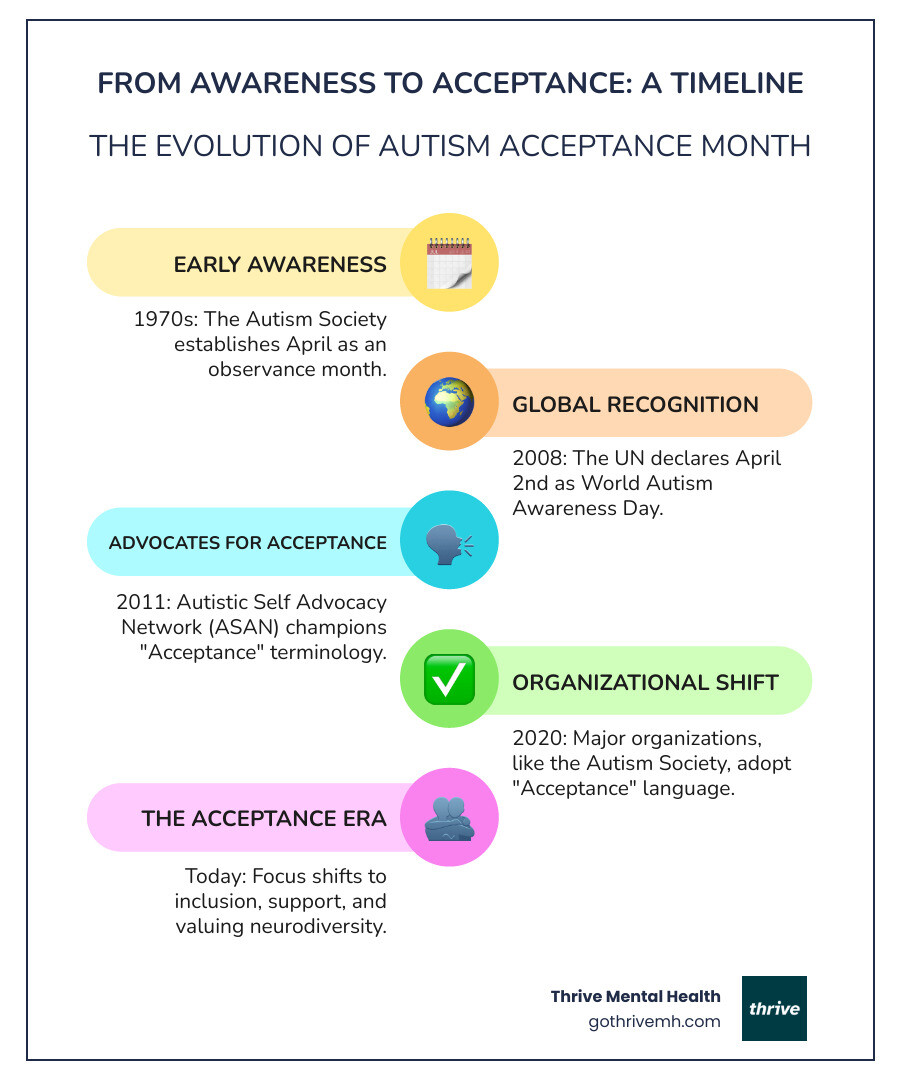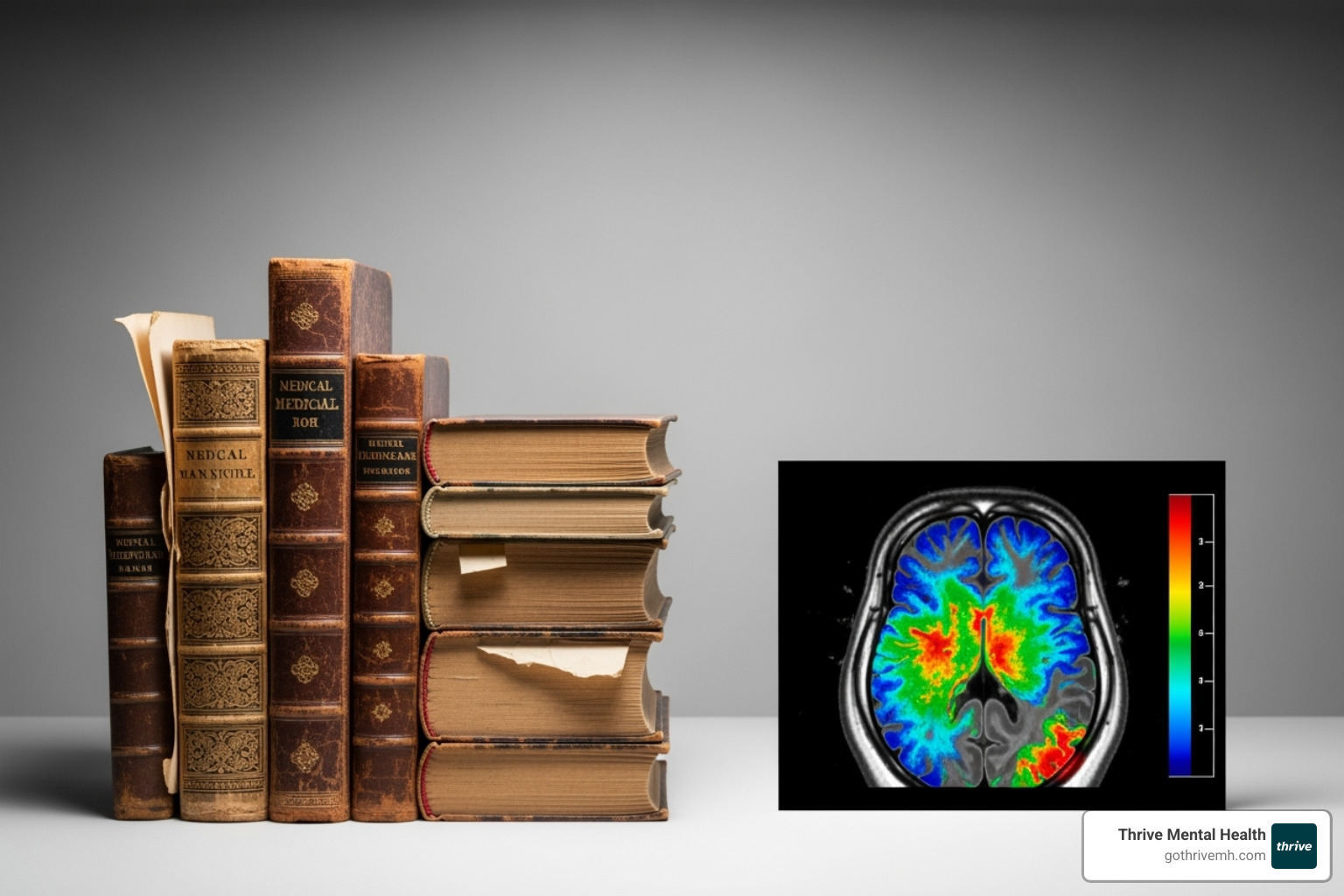Autism Awareness Month Explained: Join the Movement!

Autism Awareness Month 2025: Embrace Acceptance
From Awareness to Acceptance: What’s Changed and Why It Matters
Every April, the world recognizes Autism Awareness Month to highlight autism spectrum disorder (ASD) and support the autism community. However, a significant change is underway: many organizations and advocates now call it Autism Acceptance Month.
This isn’t just a change in words; it’s a fundamental shift in perspective. Awareness is about knowing autism exists. Acceptance is about respecting autistic people as valuable members of society who deserve support and inclusion, not fixing.
This move toward acceptance has tangible mental health benefits. Research shows that when autistic individuals feel accepted, they report better self-esteem and lower rates of depression and anxiety. The shift reflects a broader understanding that autism isn’t a disease to cure, but a neurological difference to support.
Major organizations like the Autism Society of America officially adopted “acceptance” language in 2020, following the lead of autistic self-advocates who began this movement in 2011. At Thrive Mental Health, our clinicians have seen how acceptance-based approaches create better outcomes for neurodivergent clients. Understanding this shift helps us build more inclusive communities that truly support autistic individuals and their families.

Essential autism awareness month terms:
The Critical Difference: Autism Awareness vs. Acceptance
The distinction between “autism awareness” and “autism acceptance” reflects a profound evolution. For decades, campaigns focused on making the public aware of autism’s existence and characteristics. This often framed autism as a deficit to be overcome.
As autistic self-advocates gained a stronger voice, the neurodiversity movement championed a new perspective: autism is a natural variation of the human brain, not a disease. This calls for respect and support, which is the core of acceptance.
| Feature | Autism Awareness | Autism Acceptance |
|---|---|---|
| Primary Goal | To inform the public that autism exists and its signs. | To promote understanding, respect, and inclusion of autistic individuals as they are. |
| Focus | Recognizing symptoms, often implying a need for “fixing.” | Valuing autistic identity, celebrating neurodiversity, providing accommodations and support. |
| Language | Often person-first (“person with autism”). | Often identity-first (“autistic person”), as preferred by many in the community. |
| Call to Action | “Learn about autism,” “recognize early signs.” | “Listen to autistic voices,” “advocate for inclusion,” “celebrate differences.” |
| Underlying View | Autism as a medical condition or challenge. | Autism as a form of human diversity, a different way of experiencing the world. |
Acceptance moves beyond tolerance. It means actively creating environments where autistic individuals can thrive without masking their authentic selves. This shift is crucial for fostering true inclusion and valuing the unique perspectives autistic people bring to our communities.
How Acceptance Transforms Mental Health for Autistic Individuals
The impact of societal acceptance on the mental health of autistic individuals is profound. Moving from simply knowing about autism to actively celebrating neurodiversity creates a more supportive world with direct, positive consequences.
A 2018 study found that experiencing acceptance from others significantly benefits mental health, while a lack of acceptance is linked to higher rates of depression and stress. When individuals feel respected and valued, it boosts self-esteem and alleviates the pressure to “mask” autistic traits—a practice known to cause burnout, anxiety, and depression.
At Thrive Mental Health, we understand that developing effective coping mechanisms is vital. Our approach emphasizes building a supportive environment that celebrates neurodiversity. We provide affirming support that helps individuals develop strategies to manage sensory sensitivities, reduce anxiety, and build healthy social connections.
To learn more about how therapy can support autistic individuals, explore our resources on Finding Clarity: Autism Counseling and Coping Mechanisms.
The Story of Autism: A Century of Evolving Understanding

The journey to understand autism has been filled with scientific breakthroughs, painful missteps, and the powerful voices of autistic people reshaping everything we thought we knew. Not long ago, autism was deeply misunderstood, but through persistent research and advocacy, we’ve built a foundation of understanding that grows stronger each year.
Today’s view of autism as a neurological difference rather than a disorder to be “fixed” is a monumental shift. This evolution directly impacts how we observe autism awareness month, moving from a focus on deficits to celebrating the unique strengths autistic individuals bring to our world. This progress shows that science improves when it includes the voices of the people it aims to understand. For a deeper look at this journey, The evolution of ‘autism’ as a diagnosis, explained offers valuable insight.
Key Milestones in Autism History
The story of autism unfolds through pivotal moments that changed how we think about neurodiversity.
- 1911: Eugen Bleuler first used the term “autism” to describe a symptom of schizophrenia—a tendency to withdraw inward.
- 1943-1944: The modern understanding began with Leo Kanner in the U.S. and Hans Asperger in Austria. They independently described children with unique social, communication, and behavioral patterns, laying the groundwork for the diagnosis.
- 1960s-70s: The devastating “refrigerator mothers” theory incorrectly blamed cold parenting for autism, causing immense guilt for families. Thankfully, scientific evidence eventually debunked this, shifting focus to the biological factors we study today.
- 1980: The DSM-III officially recognized “Infantile Autism” as a distinct developmental condition, separating it from schizophrenia and giving it its own diagnostic category.
- 1994: The DSM-IV introduced the umbrella term “Pervasive Developmental Disorders,” which included Autistic Disorder and Asperger’s Disorder.
- 2013: The DSM-5 consolidated these into a single diagnosis: Autism Spectrum Disorder (ASD). This model uses three support levels (Level 1, 2, and 3) to better reflect the wide range of support needs among autistic individuals.
These diagnostic changes affect real people’s access to services and how society understands autism. For families navigating these terms, our resource on Understanding Autism Spectrum Disorder (ASD) and Asperger’s: Key Differences can help clarify these distinctions.
The History of Autism Awareness Month
The story of how April became autism awareness month mirrors the broader evolution in our understanding of autism.
It began in the 1970s, when the Autism Society, founded by determined parents, established a national week of awareness that later expanded to the full month. This grassroots effort aimed to educate a public that knew very little about autism.
The movement went global in 2008 when the United Nations declared April 2nd as World Autism Awareness Day, signifying international recognition of the need for support and inclusion.
A pivotal change occurred in 2011 when the Autistic Self Advocacy Network (ASAN) began calling for “Autism Acceptance Month.” Led by autistic individuals, ASAN argued that awareness had done its job; what was truly needed was genuine acceptance of autistic people as they are.
This shift gained significant momentum, and by 2020, major organizations like the Autism Society of America officially adopted the “Autism Acceptance Month” language. This marked a fundamental change, placing autistic voices at the center of the conversation.
Today, the month reflects this evolution. It’s less about tragedy and more about celebrating the unique strengths and perspectives autistic individuals bring to our communities, often symbolized by the rainbow infinity symbol of neurodiversity.
Understanding Autism in 2025: Stats, Challenges, and Support
As we observe autism awareness month in 2025, we recognize autism as a lifelong neurological condition affecting millions worldwide, each with a unique combination of strengths, challenges, and support needs.

The autism spectrum is incredibly broad. Some individuals require significant daily support, while others live independently. Many have co-occurring conditions like anxiety or depression, but autism also frequently comes with remarkable strengths, such as exceptional attention to detail, pattern recognition, or deep expertise in specific interests. The goal is not to “cure” autism, but to provide understanding, acceptance, and the right supports for autistic individuals to thrive.
The Reality of Autism Today: By the Numbers
Statistics tell a compelling story about autism’s growing recognition. According to the CDC, 1 in 36 children in the U.S. are identified with autism spectrum disorder, a notable increase from 1 in 150 in the year 2000. In Canada, 1 in 50 children and youth have been diagnosed.
These increases likely reflect better diagnostic tools and broader criteria rather than a rise in autism itself. Autism is now the fastest-growing developmental disability in the U.S. Research suggests a strong genetic link, with about 80% of cases tied to inherited genes, though environmental factors also play a role. Despite manifesting early, autism is often not diagnosed until later in life, highlighting the need for accessible diagnostic services for all ages.
Common Challenges Faced by the Autism Community
While celebrating strengths, it’s crucial to address the real-world barriers autistic individuals face. These challenges are not inherent flaws but systemic issues that require change.
- Access to Services: Navigating diagnosis, therapy, and educational support can be a maze, with disparities based on location, income, and gender. Women and girls are often diagnosed later due to different presentation patterns.
- Stigma and Exclusion: Discrimination at school, work, and in the community persists, leading to social isolation and limited opportunities.
- Healthcare Disparities: Many providers lack training in neurodiversity-affirming care, and clinical settings can be overwhelming due to sensory sensitivities, making routine medical care stressful.
- Sensory Sensitivities: Common environmental factors like fluorescent lights, background noise, or crowded spaces can be overwhelming or painful for many autistic people.
- Finding Affirming Support: The focus is shifting from traditional therapies that encourage masking to person-centered, neurodiversity-affirming interventions that support individuals’ authentic selves.
- Co-occurring Mental Health Conditions: Anxiety, depression, and ADHD are common among autistic individuals and require integrated mental health support that understands the intersection of these conditions.
At Thrive Mental Health, we work to provide flexible, evidence-based care that meets these challenges. For families navigating these complexities, our resources on Parenting Neurodivergent Children: Essential Tips and Advice offer practical guidance.
How You Can Champion Change During Autism Awareness Month

Autism Acceptance Month is about taking real action to create a world where autistic individuals thrive as valued members of our communities. Every conversation you start, business you support, and barrier you help remove makes a difference.
Whether you’re a parent, educator, employer, or ally, there’s a place for you in this movement. This month is a focused time to channel our energy toward meaningful change.
Get Involved: 5 Ways to Participate and Celebrate
Here are five powerful ways you can make a lasting impact during Autism Acceptance Month and beyond.
- Educate Yourself and Bust Myths. Start by learning about neurodiversity from autistic people themselves. Follow the #ActuallyAutistic hashtag and listen to organizations led by autistic individuals, like the Autistic Self Advocacy Network (ASAN). Challenge harmful misconceptions wherever you encounter them.
- Support Autistic Creators and Businesses. Put your money where your values are. Seek out autistic-led enterprises, artists, and authors in your community and online. Your patronage creates economic opportunities and celebrates the incredible talents within the autism community.
- Show Up for Local Events. Participate in community walks, fundraisers, or sensory-friendly gatherings. In communities across Florida, local autism organizations often host events that bring people together in meaningful ways.
- Advocate for Systemic Change. Use your influence to push for inclusive policies in schools and workplaces. Support legislation like the Autism CARES Act in the U.S. or Canada’s developing national autism strategy. Encouraging neurodiversity training in your organization creates lasting change.
- Donate Strategically. Contribute to organizations that align with acceptance-based principles, such as the Autism Society of America, ASAN, The Arc, or Color of Autism. Many offer convenient online donation options or allow you to create personalized fundraising pages.
Finding and Funding Support Services
Navigating support services can be overwhelming, but resources are available. Understanding your options and how to fund them is a critical step.
- Resource Organizations: The Autism Society of America operates over 70 local affiliates, while The Arc advocates for human rights. For self-advocacy resources, look to the Autistic Self Advocacy Network (ASAN).
- Government Initiatives: The Autism CARES Act funds research and services across the U.S. In Canada, a national autism strategy is being developed to improve equitable access to support.
- Corporate & Community Support: Many companies and community initiatives partner with autism organizations to raise funds and amplify messages of acceptance.
- Insurance Coverage for Therapy: Accessing mental health care is essential. Many providers in Florida accept major insurance plans, including Cigna, Optum, and Florida Blue, for services like intensive outpatient (IOP) and partial hospitalization (PHP) programs. Online therapy can be a particularly effective option, offering a comfortable and accessible environment.
If you’re seeking comprehensive, evidence-based care custom to neurodivergent needs, explore our Neurodivergent Intensive Outpatient Treatment options. We’re here to help you steer the path to well-being.
Frequently Asked Questions about Autism Acceptance Month
As autism awareness month evolves into Autism Acceptance Month, many people have questions about this important shift. Here are answers to some of the most common ones.
Why did the name change from Autism Awareness Month to Autism Acceptance Month?
The shift from “awareness” to “acceptance” was driven by autistic self-advocates. While awareness brought autism into the public eye, it often framed it as a problem to be solved. Acceptance goes deeper, promoting respect, inclusion, and support for autistic people as they are, recognizing autism as a natural and valuable form of human diversity.
What is the 2025 theme for Autism Acceptance Month?
While themes vary, “Celebrate Differences” is a powerful and enduring one for 2025. It encourages everyone to move beyond tolerance and actively celebrate the unique perspectives, talents, and contributions of autistic individuals. Other action-oriented themes include “Act Fearlessly” and “Acceptance is Action,” reminding us that true acceptance requires concrete steps.
What is the symbol for autism acceptance?
The rainbow infinity symbol is the preferred symbol for autism acceptance and the broader neurodiversity movement. The infinity shape represents the endless possibilities of autistic people, while the rainbow colors celebrate the diversity of the autism spectrum. Many autistic people prefer it over the traditional puzzle piece, which can imply that they are incomplete or a mystery to be solved.
How can I be a better ally to autistic people?
Being a good ally starts with listening. Follow the #ActuallyAutistic hashtag on social media to learn from autistic individuals directly. Use your voice to challenge myths and advocate for inclusion in your school, workplace, and community. Instead of assuming what someone needs, ask. Respecting the expertise of autistic people on their own lives is the most important step you can take.
Conclusion: From Acceptance to Action
The evolution from autism awareness month to Autism Acceptance Month is more than a name change—it’s a call to action. It reflects the powerful advocacy of autistic voices reminding us that awareness without acceptance is incomplete. This shift requires us to move from simply knowing about autism to actively creating inclusive spaces where autistic individuals can thrive.
This collective effort has a direct impact on well-being. Research shows that acceptance and affirmation significantly reduce rates of anxiety and depression in the autism community. When autistic individuals feel valued and understood, they are empowered to live more authentic and fulfilling lives.
At Thrive Mental Health, we are committed to this principle. Our flexible, evidence-based care is designed to honor each person’s unique neurotype while providing the tools to steer life’s challenges. We believe mental health treatment should celebrate neurodiversity, not try to eliminate it. Our programs are custom to address the unique mental health needs of autistic adults, from managing sensory sensitivities to treating co-occurring conditions.
To learn more about our neurodiversity-affirming treatment options, explore our Comprehensive Autism Therapy: From Personalized Treatments to Online Support Programs. Let’s carry the spirit of acceptance into every month, building communities where everyone can truly thrive.
Ready for support? Thrive offers virtual and hybrid IOP/PHP with evening options. Verify your insurance in 2 minutes (no obligation) → Start benefits check or call 561-203-6085. If you’re in crisis, call/text 988.